Cognitive Mechanisms of Placebo and Nocebo Effects
Introduction
The cognitive mechanisms of placebo and nocebo effects are a fascinating area of study within the field of psychology and neuroscience. The placebo effect refers to a beneficial outcome resulting from a person's belief in the efficacy of a treatment, even if the treatment itself is inert. Conversely, the nocebo effect refers to a negative outcome resulting from a person's belief that a treatment will have harmful effects. Both phenomena are largely influenced by psychological and neurobiological mechanisms, including expectation, conditioning, and emotional processing.


Cognitive Mechanisms
Expectation
One of the primary cognitive mechanisms involved in both placebo and nocebo effects is expectation. This is the belief or anticipation that a certain outcome will occur following a specific event or action. In the context of placebo and nocebo effects, the expectation of a positive or negative outcome can significantly influence the actual outcome of a treatment.
Conditioning
Another key mechanism is conditioning, a learning process through which associations are made between a specific stimulus and a response. Conditioning can contribute to placebo and nocebo effects when a person has previously experienced a certain outcome (positive or negative) with a specific treatment, leading them to expect the same outcome in the future.
Emotional Processing
Emotional processing is also a crucial factor in the placebo and nocebo effects. The way a person interprets and responds to emotional information can influence their expectations and perceptions of a treatment, thereby affecting the outcome.
Neurobiological Mechanisms
Neurotransmitters
Various neurotransmitters play a role in the placebo and nocebo effects. For instance, the release of endogenous opioids, substances produced by the body that reduce pain perception, is often implicated in the placebo effect. On the other hand, the neurotransmitter cholecystokinin is involved in the nocebo effect, as it can enhance pain perception.
Brain Regions
Specific brain regions are also involved in these effects. The prefrontal cortex, associated with expectation and decision-making, and the anterior cingulate cortex, involved in emotion processing, are two key areas. Other regions, such as the periaqueductal gray, are involved in the modulation of pain, a common factor in placebo and nocebo effects.
Clinical Implications
Understanding the cognitive and neurobiological mechanisms of placebo and nocebo effects has significant implications for clinical practice. It can help healthcare providers optimize treatment outcomes by harnessing the power of expectation and conditioning, while also minimizing the potential negative effects of nocebo responses.
Conclusion
The cognitive mechanisms of placebo and nocebo effects are complex and multifaceted, involving various cognitive processes and neurobiological systems. Further research is needed to fully understand these mechanisms and their implications for healthcare and treatment outcomes.
